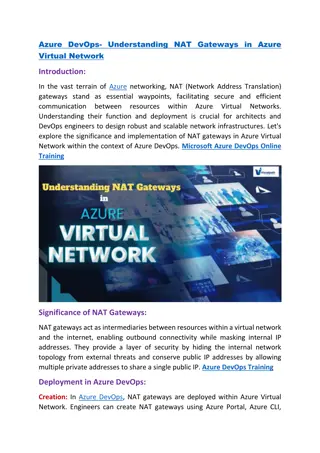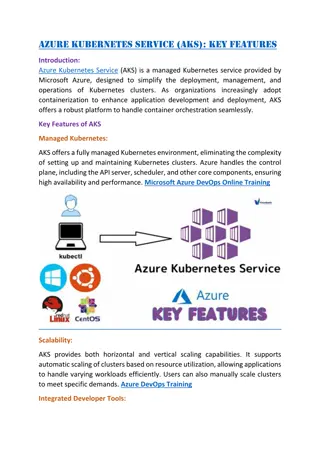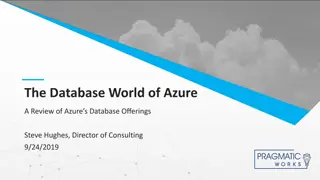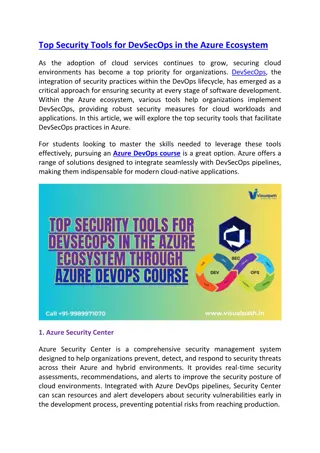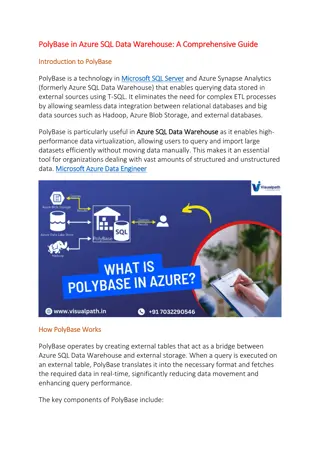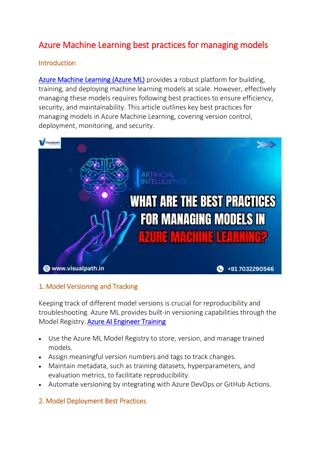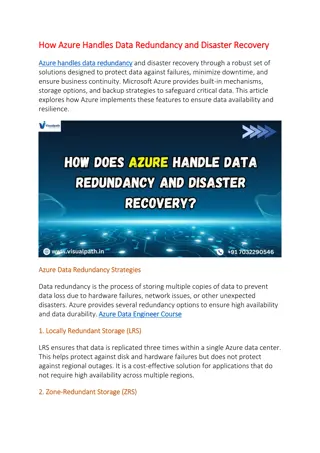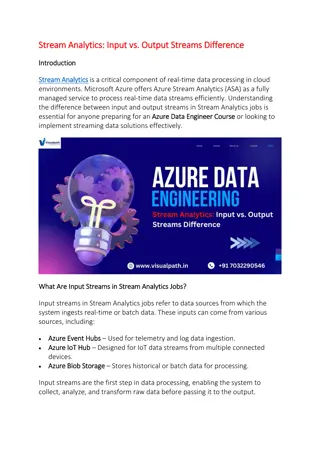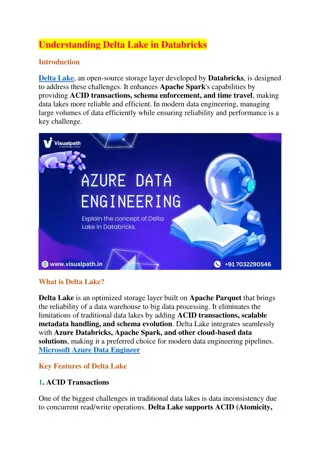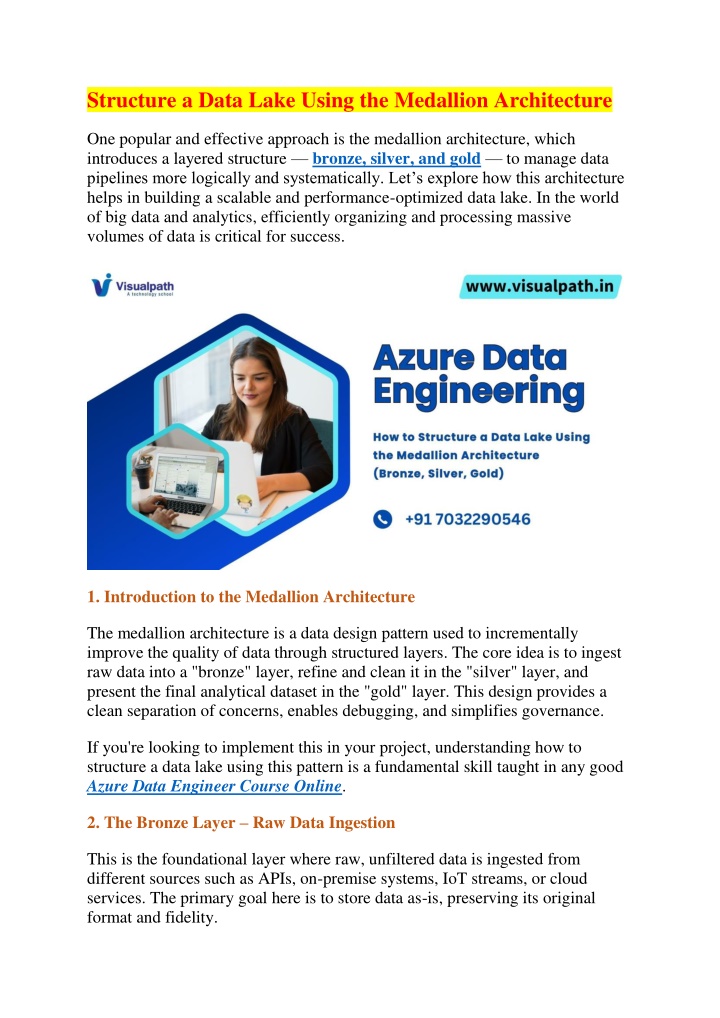
Best Course in Hyderabad | Azure Data Engineer Online
Kickstart your cloud career with VisualPathu2019s Azure Data Engineer Course, designed for real-world success. Our Azure Data Engineer Online Training includes hands-on labs, expert guidance, flexible weekend schedules, and lifetime access to record
Download Presentation

Please find below an Image/Link to download the presentation.
The content on the website is provided AS IS for your information and personal use only. It may not be sold, licensed, or shared on other websites without obtaining consent from the author. If you encounter any issues during the download, it is possible that the publisher has removed the file from their server.
You are allowed to download the files provided on this website for personal or commercial use, subject to the condition that they are used lawfully. All files are the property of their respective owners.
The content on the website is provided AS IS for your information and personal use only. It may not be sold, licensed, or shared on other websites without obtaining consent from the author.
E N D
Presentation Transcript
Structure a Data Lake Using the Medallion Architecture One popular and effective approach is the medallion architecture, which introduces a layered structure bronze, silver, and gold to manage data pipelines more logically and systematically. Let s explore how this architecture helps in building a scalable and performance-optimized data lake. In the world of big data and analytics, efficiently organizing and processing massive volumes of data is critical for success. 1. Introduction to the Medallion Architecture The medallion architecture is a data design pattern used to incrementally improve the quality of data through structured layers. The core idea is to ingest raw data into a "bronze" layer, refine and clean it in the "silver" layer, and present the final analytical dataset in the "gold" layer. This design provides a clean separation of concerns, enables debugging, and simplifies governance. If you're looking to implement this in your project, understanding how to structure a data lake using this pattern is a fundamental skill taught in any good Azure Data Engineer Course Online. 2. The Bronze Layer Raw Data Ingestion This is the foundational layer where raw, unfiltered data is ingested from different sources such as APIs, on-premise systems, IoT streams, or cloud services. The primary goal here is to store data as-is, preserving its original format and fidelity.
Key Features: oHigh volume and velocity oMinimal transformation oAudit and traceability maintained Technologies Used: oAzure Data Factory, Azure Databricks, Event Hubs, IoT Hub This layer acts as a staging zone where data is simply stored for future processing. It s not suitable for direct analytics because the data hasn t been cleaned or standardized yet. 3. The Silver Layer Data Cleaning and Enrichment Once the raw data is ingested, the silver layer processes it by performing cleansing, validation, deduplication, and enrichment tasks. This layer ensures that the data is trusted and ready for downstream analysis. Key Features: oData filtering and validation oBusiness rule enforcement oFormat standardization Technologies Used: oAzure Synapse Analytics, Azure SQL Database, Azure Databricks This layer is essential for transforming data into meaningful and reliable datasets. This is where your knowledge from Azure Data Engineer Training truly shines, as you're applying real-world processing logic and business rules to raw inputs. 4. The Gold Layer Curated, Analytics-Ready Data The gold layer contains the refined, business-ready data used by analysts and reporting tools. It typically includes aggregated metrics, historical trends, and denormalized tables designed for speed and usability. Key Features: oHigh-quality, curated data oReady for BI and ML applications oUsed for dashboards, reports, and KPIs Technologies Used: oPower BI, Azure Analysis Services, Azure Synapse Analytics This layer is directly consumed by decision-makers and data scientists. You ensure performance optimization and clear documentation at this stage.
5. Benefits of the Medallion Architecture Implementing this structured layering provides several advantages: Scalability: Easily handles petabyte-scale data. Maintainability: Simplifies data pipeline debugging and updates. Security: Layer-based access control enhances data governance. Performance: Gold layer enables fast BI reporting with clean data. Conclusion Adopting the medallion architecture helps streamline your Azure data lake strategy, ensuring each data layer serves its purpose from ingestion to transformation to consumption. By applying this structured approach, data engineers can deliver trusted and insightful analytics efficiently. Whether you're starting your journey or enhancing your cloud data skills, mastering this concept is a key part of Azure Data Engineer Training Online. Trending Courses: Artificial Intelligence, Azure Solutions Architect, SAP AI Visualpath stands out as the best online software training institute in Hyderabad. For More Information aboutthe Azure Data Engineer Online Training Contact Call/WhatsApp: +91-7032290546 Visit: https://www.visualpath.in/online-azure-data-engineer-course.html






